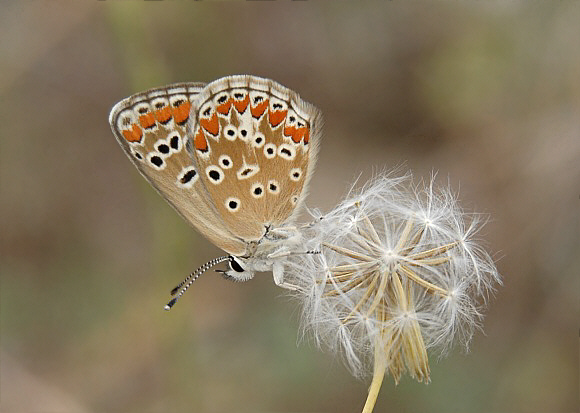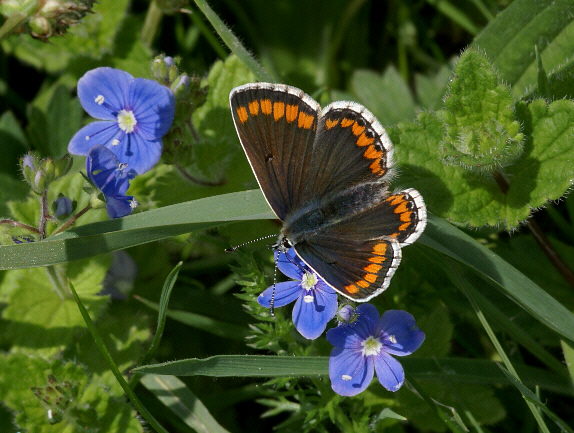
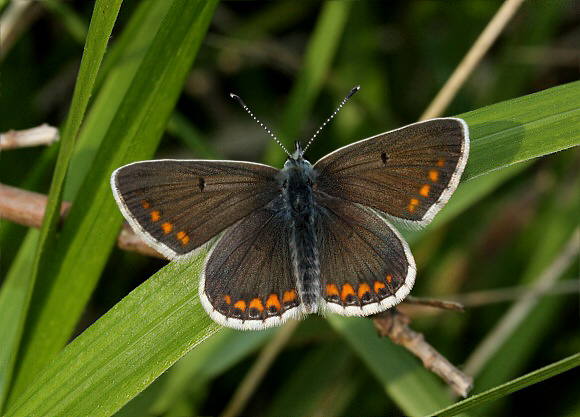
Introduction
The Brown Argus is a widespread and fairly common species found throughout most of Europe, with the exceptions of Scandinavia, Ireland and northern Britain. It also occurs in north Africa, the Middle East, and across temperate Asia as far east as Siberia and Amur.
Across most of it’s range there are 2 overlapping generations, emerging in May and August, but in the Mediterranean region there are usually 3 broods, in April, July and October.
In northern England, Scotland, Scandinavia, and the high alpine regions of Europe it is replaced by the Northern Brown Argus ( = Mountain Argus ) Aricia artaxerxes, which differs from the Brown Argus in being single brooded. There is much variation between the various races of artaxerxes, the Scottish form for example having a white discal spot on the upperside forewing, and greatly reduced black spots on the underside. The subspecies allous, found in the Alps and Pyrenees, is virtually identical to agestis on the underside, but has reduced orange lunules on the upperside.
Habitats
In England the Brown Argus breeds mainly on calcareous ( limestone / chalk ) grassland, where the caterpillar’s foodplant common rockrose grows amongst fine grasses. Many sites are on south facing slopes, often heavily grazed by rabbits, and characterised by an abundance of ant-hills on which the foodplants grow.
Around the coast of Britain there are colonies on cliff tops, and on the calcareous dunes of Wales, Cornwall, Norfolk, Suffolk, Essex and Kent.
Away from calcareous habitats the butterfly is much scarcer, but is sometimes found in odd habitats, e.g. a friend photographed a fresh female seen along a track through a Surrey woodland on clay in late July 2008.
Lifecycle
Males of the first brood begin to emerge in early May, and females about a week later. They have a potential lifespan of about 2 weeks, but on average most live for less than a week. The emergence is protracted, and the 2 broods often overlap at sites where populations are large.
The disc-shaped dull whitish eggs are laid singly on the underside of leaves of common rockrose Helianthemum chamaecistus, usually close to the stem. At certain sites, other foodplants are used, including common storksbill Erodium cicutarium and dove’s foot cranesbill Geranium molle. The eggs hatch after about 7 days.
When young the caterpillars nibble at the underside of the leaves, leaving the upper cuticle intact, which creates distinctive shiny patches visible on the upper surface.
The fully grown larva is plump and green, with a purple stripe below the spiracles, and another on the back. It feeds by day, resting on the upperside of the leaves, and is attended by ants including Lasius niger, L. alienus, L. flavus and Myrmica sabuleti, which “milk” it for a sugary secretion.
The chrysalis is formed in July on the ground, and is also attended by ants, which bury it just below the surface. It is dull olive in colour, marked with a pinkish lateral line.
The second generation of adults emerges from mid July and continues well into August. Caterpillars resulting from this brood go into hibernation when quite small, in the 2nd or 3rd instar. The diapause continues until February or March of the following year when they awake and resume feeding. They develop quickly, and pupate at the end of March.
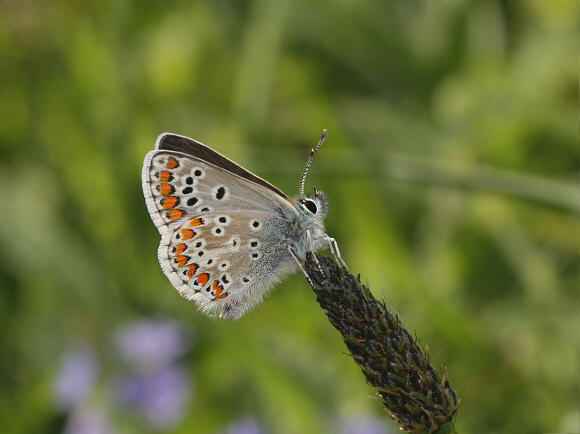
Adult behaviour
Brown Argus males tend to congregate in sheltered areas along dykes or at the bottom of south facing hills. They do not have fixed territories, but perch in various positions on grasses and flowers, and fly up instantly to investigate every passing insect. They are not the cleverest of butterflies, and seem unable to differentiate visually between flies, Skippers, Blues and Fritillaries.
They also seem unable, from more than a few centimetres away, to recognise butterflies with which they have already had sorties, and will e.g. intercept the same individual Common Blue or Marsh Fritillary numerous times if it crosses their path again. However, during these inter-species aerial encounters they make very close contact, and almost certainly “exchange names” via pheromone detection. At this point they recognise that the intruder is not of their own species, and break off the encounter.
Females that have already mated are chased by males until they settle. They then close their wings and remain motionless in an attempt to escape detection. This ploy rarely works however and the males usually locate them and attempt to copulate, but quickly give up and fly off if the female is unwilling.
When virgin females are intercepted, the female weaves in flight just above the grasses, closely followed by the male. This is very brief however, and copulation takes place within a few seconds of the sexes meeting. Once copulated the butterflies are extremely reluctant to move from the grass blades on which they settle.
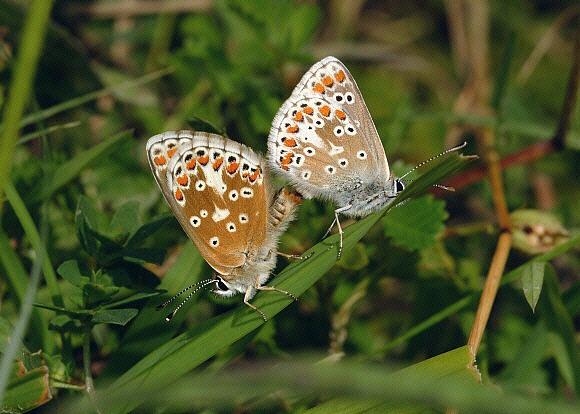
After mating the females roam randomly, searching for spots where the larval foodplants grow in warm and sheltered positions. At many sites, e.g. Martin Down in Hampshire, and Levin Down in West Sussex, the females seek rockrose plants that are growing on ant-hills, and it is possible that they are genetically programmed to recognise the chemical odours produced by the ants.
Adults of both sexes nectar at a wide variety of low growing flowers, the first brood favouring daisy, buttercup, bird’s foot trefoil, horseshoe vetch, common vetch, milkwort, dandelion and rockrose. Summer brood adults tend to congregate to nectar at clumps of marjoram at the base of hills.
In late afternoon the butterflies roost communally on grass-heads, usually with the males and females forming separate groups. The roosting sites are often on the top of banks, where the adults are exposed to the last rays of the setting sun.
